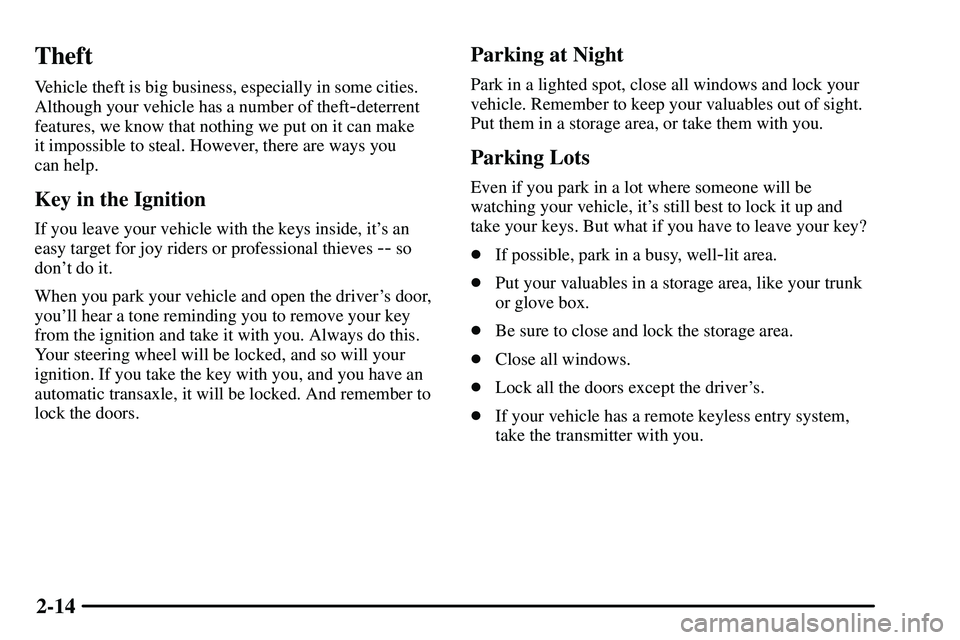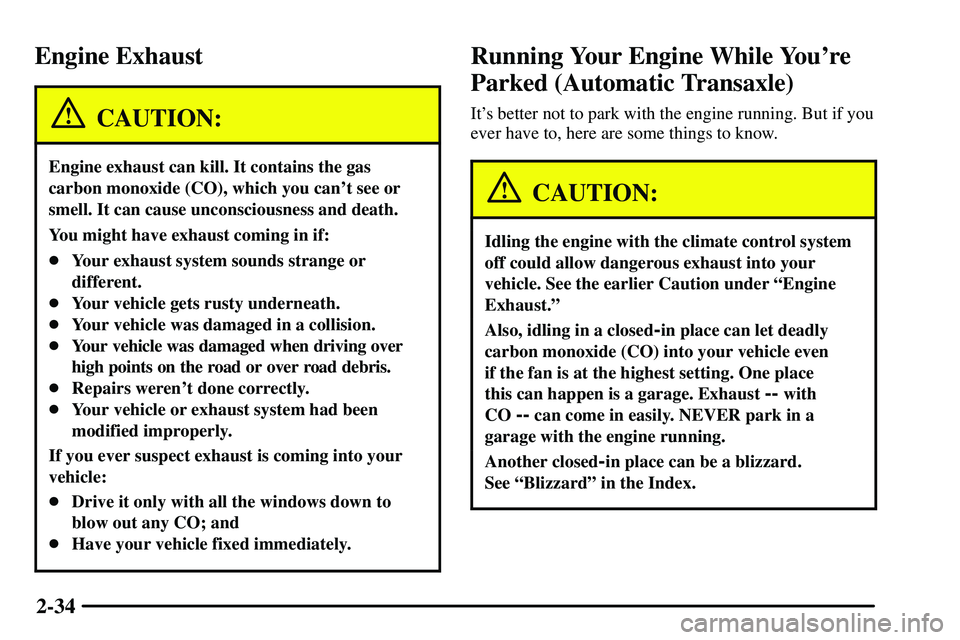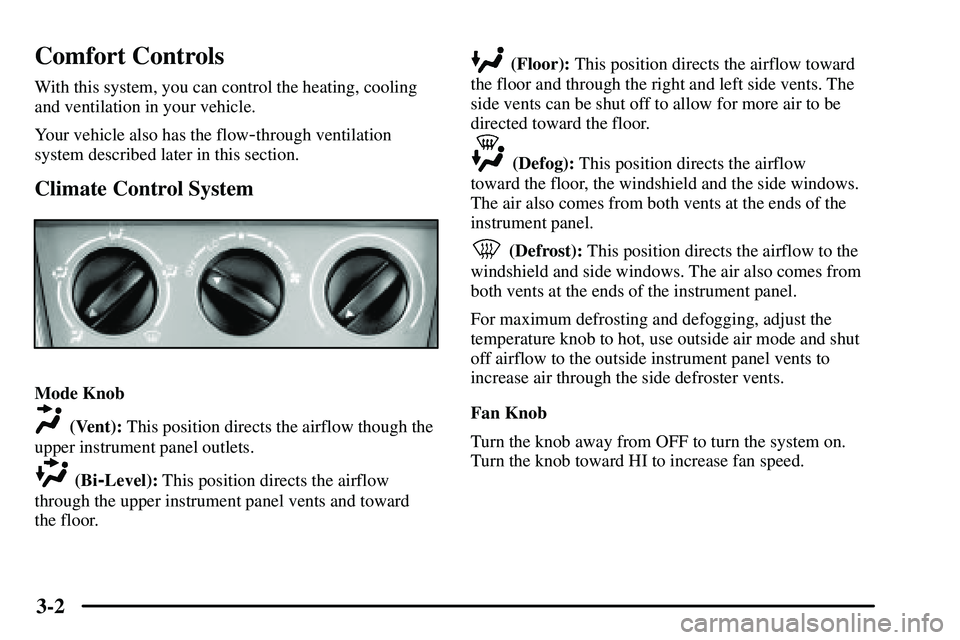Page 78 of 381

2-14
Theft
Vehicle theft is big business, especially in some cities.
Although your vehicle has a number of theft
-deterrent
features, we know that nothing we put on it can make
it impossible to steal. However, there are ways you
can help.
Key in the Ignition
If you leave your vehicle with the keys inside, it's an
easy target for joy riders or professional thieves
-- so
don't do it.
When you park your vehicle and open the driver's door,
you'll hear a tone reminding you to remove your key
from the ignition and take it with you. Always do this.
Your steering wheel will be locked, and so will your
ignition. If you take the key with you, and you have an
automatic transaxle, it will be locked. And remember to
lock the doors.
Parking at Night
Park in a lighted spot, close all windows and lock your
vehicle. Remember to keep your valuables out of sight.
Put them in a storage area, or take them with you.
Parking Lots
Even if you park in a lot where someone will be
watching your vehicle, it's still best to lock it up and
take your keys. But what if you have to leave your key?
�If possible, park in a busy, well
-lit area.
�Put your valuables in a storage area, like your trunk
or glove box.
�Be sure to close and lock the storage area.
�Close all windows.
�Lock all the doors except the driver's.
�If your vehicle has a remote keyless entry system,
take the transmitter with you.
Page 80 of 381

2-16 Testing the System
To test the system, do the following:
1. Open all the windows.
2. Set the system as described in the previous
procedure. The side doors and liftgate should be
locked with the key or remote keyless entry
transmitter. Be sure to wait until the indicator light
starts flashing.
3. Unlock the driver's door from the inside. The system
should activate the alarm.
4. Stop the alarm as described in the cancelling
procedure.
5. Repeat this operation for the other doors. Also check
that the system is activated when the battery terminal
is disconnected and then reconnected.
If the system does not work properly, have it
checked by your dealer.
Activating the System
The system will activate the alarm under the following
conditions:
�If the driver's or front passenger's door is unlocked
or if any of the other side doors or the liftgate is
forcibly opened without the key or remote keyless
entry transmitter.
�If the battery terminal is disconnected and then
reconnected.
�If the ignition is hot
-wired.
�If the side window glass is broken or damaged.
The indicator light will come on when the system is
activated.
If the driver's or front passenger's side doors are
unlocked without using the key or remote keyless entry
transmitter, the other side doors and the liftgate will be
automatically locked again.
After one minute the alarm will automatically stop and
the indicator light will start flashing again.
Page 98 of 381

2-34
Engine Exhaust
CAUTION:
Engine exhaust can kill. It contains the gas
carbon monoxide (CO), which you can't see or
smell. It can cause unconsciousness and death.
You might have exhaust coming in if:
�Your exhaust system sounds strange or
different.
�Your vehicle gets rusty underneath.
�Your vehicle was damaged in a collision.
�Your vehicle was damaged when driving over
high points on the road or over road debris.
�Repairs weren't done correctly.
�Your vehicle or exhaust system had been
modified improperly.
If you ever suspect exhaust is coming into your
vehicle:
�Drive it only with all the windows down to
blow out any CO; and
�Have your vehicle fixed immediately.
Running Your Engine While You're
Parked (Automatic Transaxle)
It's better not to park with the engine running. But if you
ever have to, here are some things to know.
CAUTION:
Idling the engine with the climate control system
off could allow dangerous exhaust into your
vehicle. See the earlier Caution under ªEngine
Exhaust.º
Also, idling in a closed-in place can let deadly
carbon monoxide (CO) into your vehicle even
if the fan is at the highest setting. One place
this can happen is a garage. Exhaust
-- with
CO
-- can come in easily. NEVER park in a
garage with the engine running.
Another closed-in place can be a blizzard.
See ªBlizzardº in the Index.
Page 102 of 381

2-38
LO (Low): Move the lever to LO for steady wiping at
low speed.
HI (High): Move the lever to HI for steady wiping at
high speed.
MIST: For a single wiping cycle, turn the band to
MIST. Hold it there until the wipers start, then let go.
The wipers will stop after one wipe.
REAR: To turn on the rear window wiper, twist the end
of the lever upward. The wiper does not work with the
rear liftglass open.
Be sure to clear ice and snow from the wiper blades
before using them. If they're frozen to the windshield,
carefully loosen or thaw them. If your blades do become
damaged, get new blades or blade inserts.
Heavy snow or ice can overload your wipers. A circuit
breaker will stop them until the motor cools. Clear away
snow or ice to prevent an overload.Windshield Washer
Pull the lever toward you to spray washer fluid on the
windshield. The spray will continue until you release the
lever. The wipers will run a few times. See ªWindshield
Washer Fluidº in the Index.
To squirt washer fluid on the rear window, twist the knob
upward and downward as far as it will go. The knob
automatically returns from these positions after you
release it. You can twist the lever downward to create a
large flow of water on the rear window, then twist the
lever back up to wipe the window. This feature is helpful
to quickly clear the rear liftglass when very dirty.
CAUTION:
In freezing weather, don't use your washer until
the windshield is warmed. Otherwise the washer
fluid can form ice on the windshield, blocking
your vision.
Page 123 of 381
2-59
The main components of your instrument panel are the following:
A. Air Outlets
B. Instrument Panel Cluster
C. Hazard Warning Flasher Button
D. Audio System
E. Rear Window Defogger Button
F. Front Passenger Safety Belt Reminder Light
G. Comfort Control System
H. Power Remote Control Mirror Button
I. Instrument Panel Brightness Dial
J. Rear Liftglass Release Button
K. Coinholder
L. Content Theft
-Deterrent Security Light
M. Storage CompartmentN. Turn Signal/Multifunction Lever
O. Hood Release
P. Tilt Lever
Q. Horn
R. Cruise Control Lever (Option)
S. Ignition Switch
T. Windshield Wiper Lever
U. Cigarette Lighter
V. Shift Lever
W. Power Outlet
X. Parking Brake
Y. Center Console Storage Area
Z. Glove Box
Page 141 of 381
3-
3-1
Section 3 Comfort Controls and Audio Systems
In this section, you'll find out how to operate the comfort control and audio systems offered with your vehicle.
Be sure to read about the particular systems supplied with your vehicle.
3
-2 Comfort Controls
3
-2 Climate Control System
3
-3 Air Conditioning
3
-4 Heating
3
-4 Defogging and Defrosting
3
-5 Rear Window Defogger
3
-6 Ventilation System
3
-7 Audio Systems
3
-7 Setting the Time
3
-8AM-FM Stereo with Compact Disc
Player with Equalization and Radio
Data System (RDS)3
-15 AM-FM Stereo with Six-Disc Compact
Disc Player with Equalization and Radio
Data System (RDS) (Option)
3
-25 Navigation/Radio System (Option)
3
-26 Understanding Radio Reception
3
-27 Tips About Your Audio System
3
-28 Care of Your Compact Discs
3
-28 Care of Your Compact Disc Player
3
-28 Fixed Mast Antenna
Page 142 of 381

3-2
Comfort Controls
With this system, you can control the heating, cooling
and ventilation in your vehicle.
Your vehicle also has the flow
-through ventilation
system described later in this section.
Climate Control System
Mode Knob
(Vent): This position directs the airflow though the
upper instrument panel outlets.
(Bi-Level): This position directs the airflow
through the upper instrument panel vents and toward
the floor.
(Floor): This position directs the airflow toward
the floor and through the right and left side vents. The
side vents can be shut off to allow for more air to be
directed toward the floor.
(Defog): This position directs the airflow
toward the floor, the windshield and the side windows.
The air also comes from both vents at the ends of the
instrument panel.
(Defrost): This position directs the airflow to the
windshield and side windows. The air also comes from
both vents at the ends of the instrument panel.
For maximum defrosting and defogging, adjust the
temperature knob to hot, use outside air mode and shut
off airflow to the outside instrument panel vents to
increase air through the side defroster vents.
Fan Knob
Turn the knob away from OFF to turn the system on.
Turn the knob toward HI to increase fan speed.
Page 143 of 381

3-3
Temperature Knob
Turn the knob to change the temperature of the air
flowing from the system. Turn the knob clockwise to
increase the temperature. Turn the knob
counterclockwise to decrease the temperature.
(Recirculate): Press this button, located in the
center of the instrument panel to the left of the audio
system, to recirculate inside air through the comfort
control system. An indicator light in the button will
come on to let you know the feature is in use. Press the
button again to turn off recirculate and to circulate
outside air through the system. The indicator light will
go off. Recirculate is automatically turned off when the
climate control system mode knob is turned to defog or
defrost or is between modes.
Air Conditioning
A/C (Air Conditioning): Press the A/C button, located
in the center of the instrument panel to the left of the
audio system, to change your comfort control system to
air conditioning. An indicator light will come on when
the air conditioning is on. Air conditioning can also
control the humidity in your vehicle. The incoming air is
cooled and dehumidified.
The air conditioner works best if you keep your
windows closed. On very hot days, open the windows
just long enough for the hot air to escape.
For normal cooling, press the A/C button and make sure
to use outside air. For faster cooling, also press the
recirculate button. Then move the mode knob to vent
and turn the temperature control knob counterclockwise.
Turn the fan knob to HI.
On days when it is raining or the humidity is high,
follow these dehumidifying steps instead of the cooling
directions. It will help clean windows that are cloudy
with moisture.
1. Press the A/C button.
2. Turn the mode knob to defrost. Recirculate will be off.
3. Turn the fan knob to HI and adjust the temperature
knob to a comfortable setting.